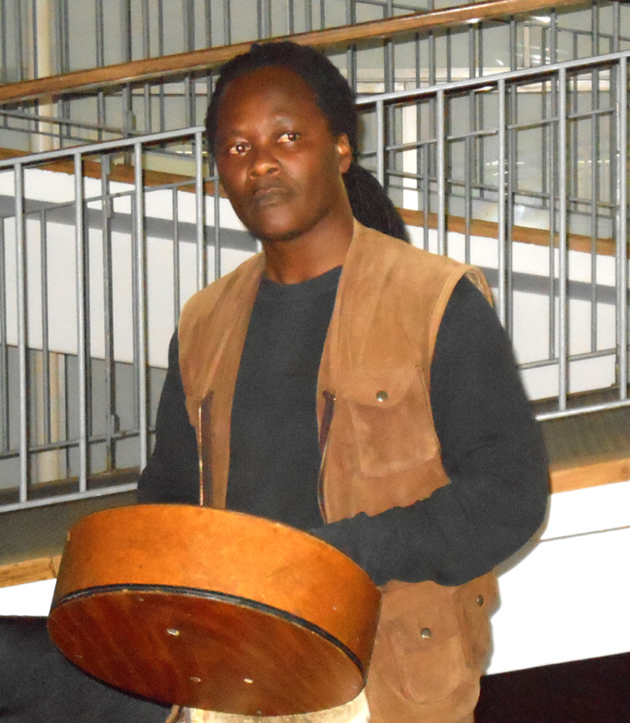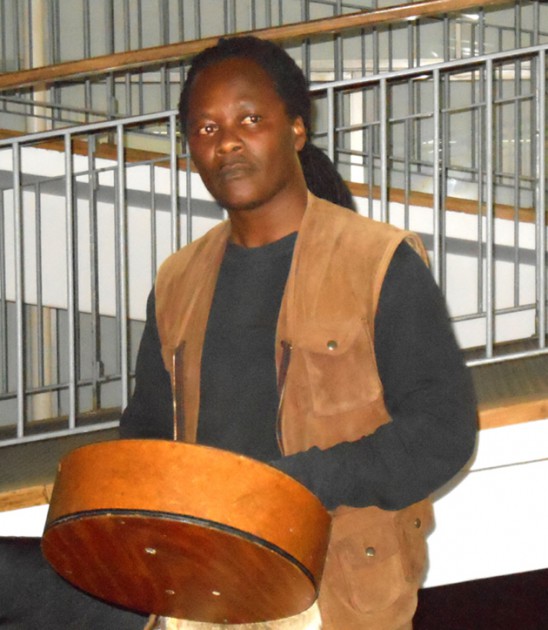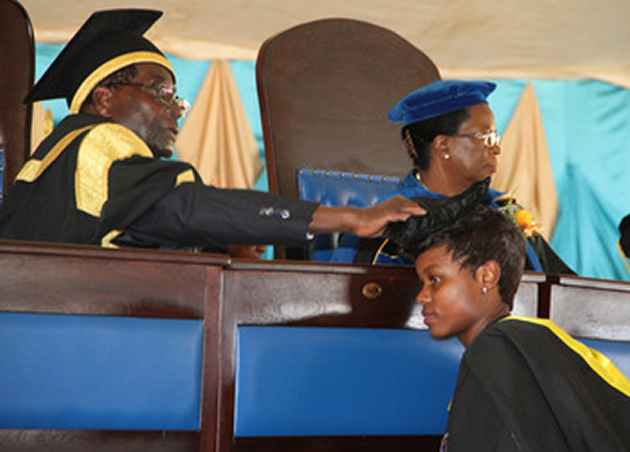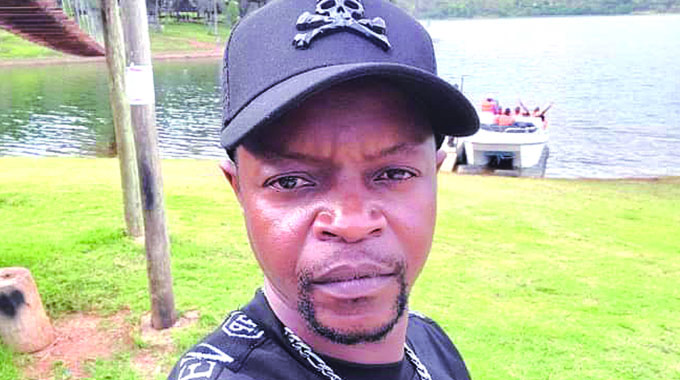Iconic artists collaborate to cross bridge

 Stephen Garan’anga Visual Art
Stephen Garan’anga Visual Art
A burnt sienna leather jacket of great significance hangs on one of the pristine walls of the ground floor of National Gallery of Zimbabwe in Harare. It is fabulous but tattered. Bits of its fallen strips lay just over a metre below it on the sparkling aged 1957 wooden floor tiles.
Hardly two metres directly ahead of the disintegrating jacket a few months old puppy of the same colour gazes up the wall wondering about this transformation.
It is up for a bash for being wrongly accused for the dilapidation. Oops, my mistake, it’s not a leather jacket. It is a rusty thin sheet of welded metal jacket titled ‘Ngubani’ a question in Ndebele language meaning ‘who?’
On a far end of the same floor on a white painted platform, a recently well welded long jacket of strong metal sheets with immaculate designs and precise folds hangs over a common metal chair in a piece titled “The Absent Father’s Jacket”.
Here the piece foretells a story about a father who opted out of his child’s life and responsibilities only to emerge for re-engagement when the abandoned child is a grown-up man with family leading a successful life.
Erected at the centre of the lower exhibiting space is a massive oversized hot metal jacket proposed for the National Gallery’s permanent collection titled “Hot Jacket”.
A number of red hot six heat plates of both big and small plates of two and four plate ancient stoves have been stripped to bear a new lease of life under the world’s attention in an art creation. They make up much of the back to front intrinsic details together with their switches and other various designs of the overcoat. Back to the walls there is a cheap quality black jean-like or denim jacket hung awkwardly inside out on a leftover of an upside down wooden chair with a thin metal sheet finishing on both ends of the arms’ sleeves.
The narration is that some people agree on some things and promise to attend to the matters but later change their mind.
The French will then say why did you decide wear your jacket inside-out.
The entirety of lower deck walls of the lower deck sing hung jackets of all shapes and sizes from various materials which include thorns, chains, condoms, lengthy strips of thin metals sheets to mention a few.
“Jackets” is the formidable theme that the artist Israel Israel strenuously decided to tackle saying we are all souls housed in a jacket or perhaps in many jackets of many colours which can change the way we are viewed by others.
He said “The Jacket can be physical – a smart suit, a police uniform, designer clothes, symbolic, a title, a qualification, a surname, a position power or psychological of fear, of pretence, of confidence. We don’t often look beneath the jacket a judge’s clothes symbolises power that we challenge at our peril, a doctor is treated with more respect than a shop assistant without knowing anything about the real person. And we can be deceived by the jacket.” A jacket may be a protective mantle for the family, but who is to blame for the jacket becoming torn? We may wear a jacket of thorns, sacrificing our own interests for the good of those we love. Our jackets may chain us, physically or psychologically to an existence we abhor; we need the right key to free ourselves to live a better life. But jackets can protect us from harm, as in “ijazi lomkhwenyana” (one of his metal pieces on show).
We can use our jackets in many ways: positively, negatively, or we may try to ignore the jacket. And we may change our minds as to the correct jacket to wear. But he jacket may grow depending on how it is fed by our actions during life; we need perseverance to keep making the right decisions as we make our way on the journey through life.
Some jackets are earned or acquired for example through education, or through a career (police uniform), some jackets confine you so you need to “unlock your chains”, as in the “Freedom Jacket” (another of his pieces on show)”.
On the other hand three time consecutive National Arts Merit Awards winning artist Forbes Mushipe brought to the fore an array of high energy emitting found object crucified in mixed media pieces that include two of his award winning piece called “Melodies from the Maimed’ and “Nhapwasikana”.
He incorporates dead bits of ancient hardwood, welded metal, bones and other materials. In one of his pieces titled “Fruit of a Womb” his master craftsmanship and blacksmith abilities welded a gorgeous dressed female head in agony supported from the ground by awkward looking metal arms curving and twisting towards the centre ground only to be intercepted by twin thicker ends of huge kudu bull’s horns.
The first wider curves of the twisting and curving horns touch the ground of a wider flat panel of aged wood with protruding thick industrial bolts. The grounded curves become the lying woman’s behind safeguarding the in-between well carved smooth spherical piece of hard wood representing the bulging tummy or the “Fruit of a Womb”.
The horns extend curving upwards to curve downwards forming the knees then the thinner ends form the lower limbs of the pregnant woman.
Other special pieces of the duo are well displayed on the upper deck of the Gallery and they include three of their respective National Arts Merit Awards winning pieces.
It has been a long time coming for two of Zimbabwe’s most established visual artists practising in other sculptural forms other than the mighty conquering stone to collaborate from outside Harare to come to the capital and conquer the National Gallery.
The established multi award winners, Israel Israel and Forbes Mushipe from Bulawayo and Gweru respectively brought their best together in their debut two men travelling show that started in Bulawayo to its final destination of Harare under the theme “Crossing the Bridge”.
Mushipe crossed the bridge to exhibit at the National Gallery of Zimbabwe in Bulawayo with Israel before they both crossed the bridge to Harare.
Apart from two other well established senior artists Voti Thebe and Rashid Joge from Bulawayo who have had solo shows at the National Gallery in Harare the two contemporary artists become the other pair from the regions to show at the iconic art place outside group shows.
This was a defining moment for the artists according to Israel Israel who was present at the recent official opening of the current show that he played “mbira” music to kick-off proceedings before an emotional educative speech.








Comments